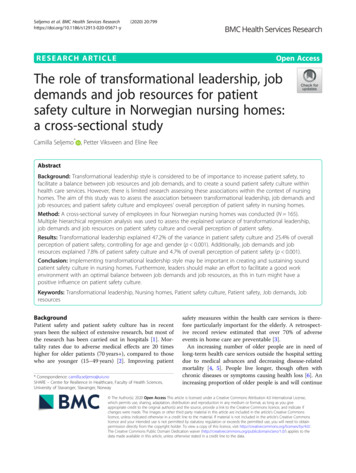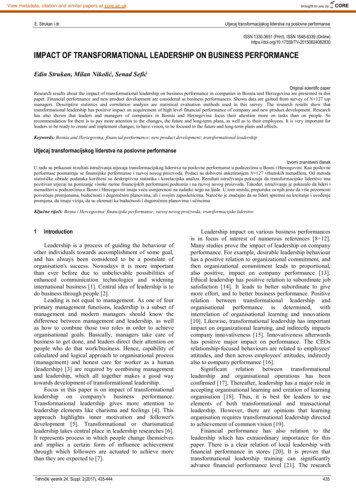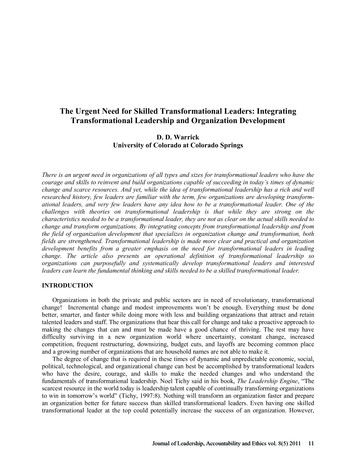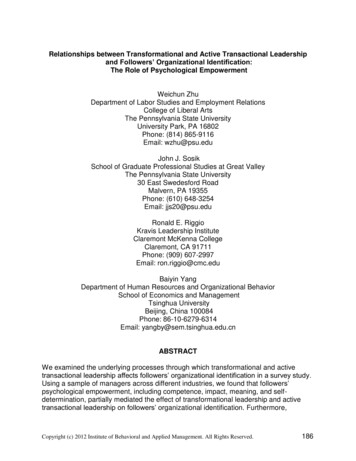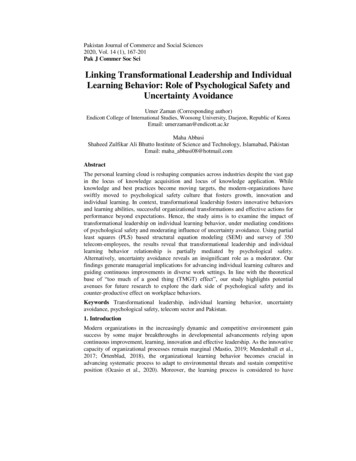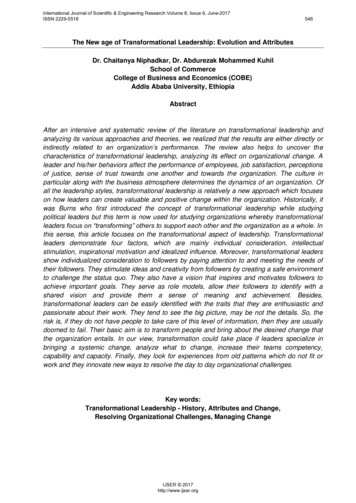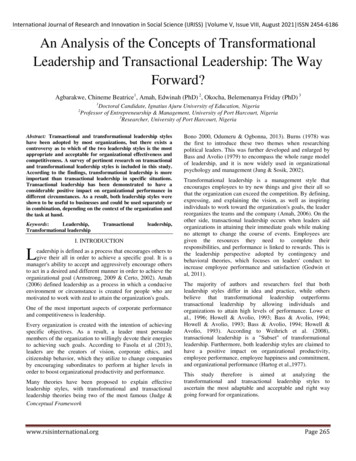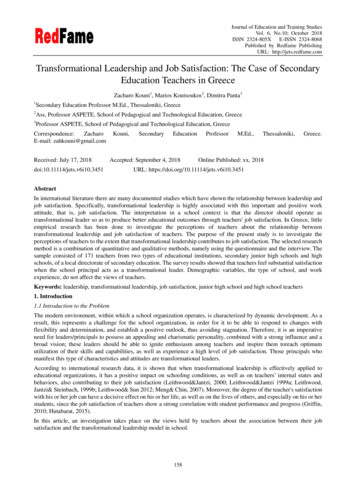
Transcription
Journal of Education and Training StudiesVol. 6, No.10; October 2018ISSN 2324-805X E-ISSN 2324-8068Published by Redfame PublishingURL: http://jets.redfame.comTransformational Leadership and Job Satisfaction: The Case of SecondaryEducation Teachers in GreeceZacharo Kouni1, Marios Koutsoukos2, Dimitra Panta31Secondary Education Professor M.Ed., Thessaloniki, Greece2Ass, Professor ASPETE, School of Pedagogical and Technological Education, Greece3Professor ASPETE, School of Pedagogical and Technological Education, GreeceCorrespondence:ZacharoE-mail: zahkouni@gmail.comReceived: July 17, cationAccepted: September 4, 2018ProfessorM.Ed.,Thessaloniki,Greece.Online Published: xx, 2018URL: https://doi.org/10.11114/jets.v6i10.3451AbstractIn international literature there are many documented studies which have shown the relationship between leadership andjob satisfaction. Specifically, transformational leadership is highly associated with this important and positive workattitude, that is, job satisfaction. The interpretation in a school context is that the director should operate astransformational leader so as to produce better educational outcomes through teachers' job satisfaction. In Greece, littleempirical research has been done to investigate the perceptions of teachers about the relationship betweentransformational leadership and job satisfaction of teachers. The purpose of the present study is to investigate theperceptions of teachers to the extent that transformational leadership contributes to job satisfaction. The selected researchmethod is a combination of quantitative and qualitative methods, namely using the questionnaire and the interview. Thesample consisted of 171 teachers from two types of educational institutions, secondary junior high schools and highschools, of a local directorate of secondary education. The survey results showed that teachers feel substantial satisfactionwhen the school principal acts as a transformational leader. Demographic variables, the type of school, and workexperience, do not affect the views of teachers.Keywords: leadership, transformational leadership, job satisfaction, junior high school and high school teachers1. Introduction1.1 Introduction to the ProblemThe modern environment, within which a school organization operates, is characterized by dynamic development. As aresult, this represents a challenge for the school organization, in order for it to be able to respond to changes withflexibility and determination, and establish a positive outlook, thus avoiding stagnation. Therefore, it is an imperativeneed for leaders/principals to possess an appealing and charismatic personality, combined with a strong influence and abroad vision; these leaders should be able to ignite enthusiasm among teachers and inspire them toreach optimumutilization of their skills and capabilities, as well as experience a high level of job satisfaction. Those principals whomanifest this type of characteristics and attitudes are transformational leaders.According to international research data, it is shown that when transformational leadership is effectively applied toeducational organizations, it has a positive impact on schooling conditions, as well as on teachers’ internal states andbehaviors, also contributing to their job satisfaction (Leithwood&Jantzi, 2000; Leithwood&Jantzi 1999a; Leithwood,Jantzi& Steinbach, 1999b; Leithwood& Sun 2012; Meng& Chin, 2007). Moreover, the degree of the teacher's satisfactionwith his or her job can have a decisive effect on his or her life, as well as on the lives of others, and especially on his or herstudents, since the job satisfaction of teachers show a strong correlation with student performance and progress (Griffin,2010; Hutabarat, 2015).In this article, an investigation takes place on the views held by teachers about the association between their jobsatisfaction and the transformational leadership model in school.158
Journal of Education and Training StudiesVol. 6, No.10; October 20182. Theoretical Context of Transformational LeadershipTransformational leadership has attracted the attention of many researchers who specialize in the field of leadershipwithin organizations (Bass &Riggio, 2014; Givens, 2008). Therefore, research has shown that the application oftransformational leadership to organizations yields positive results. These results refer to either the organization itself(performance, culture, vision) or its members (empowerment, job satisfaction, commitment, trust, self-efficacy, beliefs,and incentives/motivation) (Given, 2008; Τucker& Russell, 2004). It is a contemporary leadership theory that studies keypersonal traits, which are fostered and developed by the leader, in order for him or her to be able to inspire and influencehis or her followers and lead effectively (Robbins & Judge, 2011; Vakola& Nikolaou, 2012).The relationship between leader and follower is placed by the advocate of this theory, MacGregor Burns, on the basis ofethics, with the leader being able to understand the ethical and moral values of followers, in order to guide them, bothconscientiously and emotionally, towards reaching the goal of organizational restructuring and reform (Tosi, Mero&Rizzo, 2000; Yukl 2010). From this perspective, transformational leadership can be characterized as ethical leadership,since it strengthens human contact and fosters motivation and ethical willingness in the leader and the followers, in orderfor them to work synergistically to achieve the organizational goals (Kantas, 1993; Kanungo, 2001). In this context, aleader seeks to comprehend and satisfy the higher-level needs of his or her followers, offer them incentives to strive andimprove their practices and boost their self-esteem, and finally help them achieve superior goals (Bass, 1985; Bass et al.,2014; Κanungo, 2001; Leithwood, 1992; Vecchio, 1995).2.1 Transformational Leadership in EducationTransformational leadership is also successfully applied to educational organizations, since research data show that it hasa positive impact on schooling conditions, on teachers’ internal states and behaviors and their job satisfaction, as well ason student performance and progress (Leithwood et al., 2012; Leithwood et al., 2000; Meng et al., 2007). The practicesand behaviors of transformational school leaders have been investigated by Leithwood and his colleagues, who adaptedschool management to the theoretical models of transformational leadership that were developed and operated innon-school settings (Geijsel, Sleegers, Leithwood&Jantzi, 2002; Jantzi&Leithwood, 1995; Leithwood et al., 1999b;Theofilidis, 2012).From relevant research that has been conducted, three general characteristics-categories of transformational leadershiphave emerged: setting direction-orientation, human resources development, and organizational restructuring (Geijsel et al.,2002; Jantzi&Leithwood, 1996; Leithwood& Beatty, 2008; Leithwood et al., 1999b).-Setting direction-orientation. This refers to building a shared vision on school values, accepting the common goals thathave been set by the teachers and leader/principal, and the high teacher performance expectations being set by the leader.-Human resources development. This refers to the provision of individualized support by the school leader to the teachers,as well as causing their intellectual stimulation, in order for the latter to be able to reflect on and try new learning andteaching approaches, with the leader serving as a role model and providing the key values.-Organizational restructuring. This refers to strengthening the culture - establishing common standards, assumptions,beliefs, and values, so that the operation of the organization is focused on meeting the students’ needs and buildingpartnerships and cooperation that are oriented towards reaching the common goals set by the school, as well as facilitatingautonomous decision-making by teachers or their groups, in order to provide solutions to problems related to teaching andlearning issues.The nature of the educational system seems to play a decisive role in the implementation of such a model in schools. InGreece, for example, where the educational system is centrally planned and bureaucratic, the views of experts on theimplementation of the model are divided. A number of scholars argue that "transformational leadership lacks the potentialto emerge through the existing structured operation" (Raptis, 2006, p. 36), whereas some of them accept that "there isroom to apply its principles especially to school units that have adapted their operation according to the cooperativemanagement model (Katsaros, 2008, p. 109)". Furthermore, several researchers argue that transformational leadership iscurrently a "new trend in educational systems, after many years of adherence to the bureaucratic system(Vasileiadou&Dieronitou, 2014, p. 103)".3. Theoretical Context of Job SatisfactionSeveral researchers maintain that job satisfaction and motivation, although different concepts, are so closely related, thatthey can be included in the same theoretical context (Lowenberg& Conrad, 1998; Mullins, 2007). Motivation and jobsatisfaction have a special relationship which aims, on the one hand, to satisfy the person's need to feel that it offerssignificant work to an organization, and on the other hand, to help the leader realize this need and motivate the person(Reppa, 2008).159
Journal of Education and Training StudiesVol. 6, No.10; October 2018Motivation activates the individual's behavior through the provision of incentives, and guides it towards goal achievement,in order to satisfy the individual's needs in the workplace (Bourantas, 1992; Lowenberg et al., 1998; Reppa, 2008). Thegoals of the organization are implemented successfully when one or more needs of the individual are satisfied at the sametime (Theofilidis, 2012). Hence, motivation is linked to performance and job satisfaction, and it is important formanagement executives to know what motivates and activates employees, in order for them to carry out their duties in anoptimum way (Isac&Badshah, 2016; Kefis, 2005; Mullins, 2007).The motivation theories that are cited in literature, and which attempt to interpret job satisfaction, are normally dividedinto the following key categories: content theories and process theories (Bourantas, 1992; Mullins, 2007; Saif, Nawaz,Jan and Khan, 2012; Tosi et al., 2000; Vakola et al., 2012; Vecchio, 1995). The most popular theories that belong to thefirst category are: Maslow’s Hierarchy of Needs Theory, the ERG motivation Theory by Aldefer, Herzberg’s Two FactorTheory, Theory X and Theory Y Theory by McGregor, and the Theory of Needs-Achievement motivation theory byMcClelland. On the other hand, the most well-known theories from the second category are: the Equity Theory by Adams,the Expectancy Theory by Vroom, the Goal-Setting Theory, the Job Characteristics Model and the Social LearningTheory by Bandura.All theories agree that a capable leader tries to understand human behavior and apply powerful and effective motivation,by acknowledging the employee as the main source of quality and efficiency, capable of taking action and achievingsuccess. Knowing why and how individuals are motivated is an important advantage for a leader, when he or she aims toimprove the job satisfaction experienced by those individuals.Within the context of this study, job satisfaction is interpreted as the positive feeling that is expressed by an individual forhis or her job, when he or she evaluates its characteristics and results on the basis of the needs, incentives, values or goalsthat he or she considers as important (Drenth, Thierry & Wolff, 1998; Robbins et al., 2011).3.1 Teachers’ Job SatisfactionTeachers’ satisfaction with their profession is a major issue, since it affects how each teacher carries out his or her role,which reflects on the quality of his or her teaching work and the school operation (Ostroff, 1992). The level of theteacher's satisfaction with his or her job can have a decisive impact on both his or her life and the lives of others, andespecially on his or her students, since the job satisfaction of the teacher shows a strong correlation to the achievement ofthe latter (Griffin, 2010; Hutabarat, 2015).Covering material or mental and emotional needs is directly linked to the level of the teacher's job satisfaction and(Kampouridis, 2002). Only scientific research has the potential to identify the specific characteristics of the teachingprofession that satisfy the teachers' needs and motivate them; scientific research can also highlight those factors thatincrease job satisfaction or dissatisfaction (Bolin, 2008).In recent years, the job satisfaction of teachers has emerged as a subject that has drawn the attention of researchers(Chamundeswari, 2013). As a result, there is a series of both international and Greek research data that reveal the factorsthat can affect the job satisfaction teachers. These factors are demographic (gender, age, professional experience, level ofeducation), external (remuneration, workplace relations), or internal (achievement, autonomy, professional development,recognition of work, responsibility).In a survey conducted by Saiti and Papadopoulos (2015), it was found out that a stable job, their relationship with theschool's management and their colleagues, and the nature of the job itself, affect the level of satisfaction experienced byprimary education teachers. In the same survey, it was shown that the remuneration offered to cover material needs doesnot affect the job satisfaction experienced by teachers, although their salaries have been significantly reduced due to thedeep recession that the country is currently going through.A very satisfactory level of communication and relationship between teacher and student has a positive impact on thesatisfaction experienced by the teacher with his or her profession, as shown inthe results of a survey that was conducted byGolia (2014) on primary and secondary education teachers, with female teachers expressing a higher level of satisfaction.This finding confirms an earlier survey conducted by Zournatzi, Tsiggilis, Koustelios, and Pintzopoulou (2006), whodiscovered that a high level of job satisfaction is experienced by physical education teachers serving in primary education,as a result of their enhanced emotional bonding with their pupils. Similar conclusions can also be found in surveysconducted internationally, where the teacher-students relationship affects their self-esteem and mental health (Spilt,Koomen&Thijs, 2011).Eliophotou and Reppa (2011) conducted a survey on secondary education teachers and explored seven aspects of jobsatisfaction, in relation to the gender and experience of teachers. These seven aspects included the school climate, keystakeholders in the educational process (parents, students, and the community), support provided to the teacher in his orher work, as well as opportunities for further training, participation in management, student and school effectiveness,160
Journal of Education and Training StudiesVol. 6, No.10; October 2018professional development, and terms of employment (salary and term of employment). The survey demonstrated the factthat teachers with longer experience enjoy more satisfaction with their profession, regardless of their gender, and morespecifically, as a result of their contact with the stakeholders and their participation in the school's management.In a survey conducted by the OECD in 2013 (OECD, 2014), on lower secondary education teachers from 30 countries, itwas shown that, overall, teachers experience satisfaction with their job, with the most important factors that determine thissatisfaction being the level of cooperation among teachers, their positive relationship with their students, and theirparticipation in decision-making. Moreover, in a survey conducted by Bentea and Anghelache (2012) through theparticipation of teachers from all levels of education, it was found out that the job satisfaction of teachers results from thesatisfaction of their needs for achievement, recognition, and social relationships, since they believe that the principalacknowledges their teaching skills, there is a good level of communication in the school. Moreover, their employmentstatus, which is estimated on the basis of further training that they receive towards their professional development, servesas a factor that determines job satisfaction.4. The Relationship Between Transformational Leadership and Job Satisfaction Experienced by TeachersArguments found in modern literature on the subject favor the view that successful companies and effective schools arerun by leaders who establish those workplace conditions that enable employees to experience emotions of satisfaction(Adams & Bailey, 1989). Currently, ensuring employee satisfaction has been elevated to one of the most important dutiesthat should be carried out by those who manage organizations (Aydin, Sarier&Uysal, 2013). On those grounds, there hasbeen ongoing research on the relationship between leadership and job satisfaction, and the researchers' interest hasremained strong.Although there are relatively few studies that investigate the relationship between transformational leadership and thelevel of job satisfaction experienced by teachers (Eliophotou&Ioannou, 2016; Nguni, Sleegers&Denessen, 2006), theirfindings are particularly interesting.In a survey conducted by Sayadi (2016) on a sample of 387 teachers for 42 primary and secondary education school in Iran,aiming to investigate the implications of transformational leadership in job satisfaction and commitment to the organization,the results demonstrated the fact that the relationship between the principal and the teacher plays the role of both external andinternal motivation towards stronger job satisfaction experienced by the teacher. The teacher's trust in the principal'sjudgment, as well as in the values advocated by the latter, combined with the mission of the school, establish an emotionalbond with the leadership, which is associated with job satisfaction. Similar findings have resulted from the survey of Tesfaw(2014) about the relationship between transformational leadership and the job satisfaction of teachers, which was conductedon a sample of 320 teachers from 20 secondary education schools in Ethiopia, where the behavior of the transformationalprincipal appeared to have a strong correlation with the job satisfaction experienced by teachers. Through his or hercharismatic behavior, a transformational principal can become a role model for teachers, earn their admiration and trust, andmaintain two-way communication and a commitment culture to all the shared goals of the school.Eliophotou (2014), in her investigation of the relationship between transformational leadership, the views held by teachersabout the effectiveness of the principal/leader, and the job satisfaction experienced by teachers, which was conducted on asample of 438 teachers from 348 secondary education schools in Cyprus, concluded that, in cases of a high level of overalljob satisfaction, teachers recognize the qualitative traits of a transformational and transactional leader in the face of theirprincipal. This finding is highly interesting, bearing in mind that a centrally planned educational system does not allow theapplication of transformational leadership to the management of schools, to the extent that it has been reported in othercountries. In a survey conducted by Golia (2014) on a sample of 640teachers from 77 primary and secondary educationschool in Northern, Central, and Southern Greece, it was found out that a transformational leader can have a direct impact onthe job satisfaction of teachers, since he or she can strengthen the principal-teacher and student-teacher relationships, as wellas the relationships that develop among teachers, thus establishing satisfactory workplace conditions.In their attempt to perform a meta-analysis of twelve surveys about the influence of the type of school leadership in theorganizational commitment and job satisfaction of teachers, Aydin et al. (2013) reached the conclusion of the positiveinfluence that a transformational leader can have on job satisfaction, by motivating teachers to act towards theachievement of the school's goals and showing special attention to them.Nguni et al. (2006) investigated the influence of transformational leadership on job satisfaction, organizational commitment,and organizational citizenship behavior on a sample of 700 primary educational teachers in Tanzania. From the analysis ofdata, it emerged that transformational leadership has a positive influence on job satisfaction, thus confirming the results andfindings of earlier surveys. More specifically, according to the qualitative survey conducted by Barnett, Marsh, and Craven(2005) that was conducted on three secondary educational schools, it was shown that teachers expressed a higher level ofsatisfaction with the personalized interest demonstrated by the leader, rather than with behaviors pertaining to a visionary161
Journal of Education and Training StudiesVol. 6, No.10; October 2018leader, teaching as a profession, and the leader's place as a role model in the school's daily routine. Moreover, the leader'spresence close to the teachers on a daily basis, made the latter feel content, accept, and follow the former.What is more, in a survey conducted by Griffith (2004) on a sample of 458 teachers from 52 primary education schools inAustralia, it was shown that there is an important positive and strong correlation between transformational leadership inschools where leadership can be characterized as transformational, and the job satisfaction of teachers. In the sameschools, teachers had achieved a higher level of progress in their job.5. Method5.1 Research ObjectiveThe research objective of this survey is to contribute to the concern that is raised with regard to the influence oftransformational leadership in the job satisfaction of teachers.More specifically, it aims to investigate the views of teachers about the relationship between transformational leadershipand the general job satisfaction that teachers experience.5.2 Research QuestionsIt attempted to provide answers to the following research questions:1. To what extent do teachers believe that transformational leadership contributes to job satisfaction?2. Are views divided over whether transformational leadership contributes to job satisfaction according to the years ofprevious experience?3. Are views divided over whether transformational leadership contributes to job satisfaction according to the type ofschool?5.3 SampleThe sample of quantitative survey, which was selected randomly, consisted of secondary junior high school and highschool teachers serving at schools of Eastern Thessaloniki. Thus, from the teachers registerered at the Teachers’ Record ofEastern Thessaloniki, 171 teachers participated, 72 of whom served in junior high schools (a percentage rate of 42%), and99 in high schools (a percentage rate of 58%). In order to conduct the qualitative survey, interviews were taken from 10permanent teachers who serve at secondary and high schools, where the quantitative survey was conducted.5.4 The QuestionnaireAt the stage of quantitative research, the questionnaire method was used as it is one of the most widespread and popularresearch methods for gathering data (Robson, 2011). The questionnaire was developed specifically for the purpose ofthis case study, based on literature review, the research’s main objective and the conclusions of the qualitativeinterviews.In particular, the questionnaire of the survey included three sections of questions:a) The first section contained 2 questions relating to the size and type of the school unit (secondary of high school).b) The second section contained 5 questions relating to demographic data (gender, age, qualifications, employmentrelationships, overall teaching experience) of the subjects of the sample, andc) The third section contained 27 question-statements in seven conceptual categories-groups, which refer to the behaviorsand practices of the transformational school leaders, and which may affect the general job satisfaction of teachers. Thequestion-statements are closed-ended and marked against a grading scale: 1 to a minimum extent, 2 to a small extent,3 to a moderate extent, 4 to a large extent, 5 to a maximum extent.5.5 The InterviewsThe interview was chosen as a research tool since it examines issues in an in-depth manner and provides detailedinformation regarding personal opinions and perceptions leading, in this way, to a kind of understanding not easilyachieved using quantitative methods (Robson, 2011). More specifically, in this research the interview was structured onthree thematic axes:1st thematic axis: personal details of the responding teacher2nd thematic axis: exploring the views about the general behaviors of a male or female school principal that contribute tothe teacher's general job satisfaction3rd thematic axis: exploring the views about the most important behaviors of a male or female school principal thatcontribute to the teacher's general job satisfaction.162
Journal of Education and Training StudiesVol. 6, No.10; October 2018The interviews had an average duration of one hour, were tape-recorded and the useful conclusions deduced wereutilized as supplementary material for the final design of the questionnaire which was used at a later step.5.6 Research Validity and ReliabilityResearch validity and reliability were ensured from the beginning through the use of a multi-method approach(triangulation). Additionally, a higher content validity of the questions, and their reliability and better adaptation to theoperating context of the Greek school (Cohen, Manion&Morisson, 2008) were ensured by a pilot application of thequestionnaire to subjects who were not going to participate in the final survey. The final survey was conducted betweenMarch and April 2017, and the statistical processing of data was performed by the SPSS 20 statistical package, which isthe most appropriate one for social data and surveys conducted through the use of a questionnaire (Dafermos, 2011). In allthe statistical tests of hypotheses for generalization over the population, a maximum error possibility of α 0.05 wasdetermined as the significance level of the test (Jacobson, 1976). Each hypothesis would be rejected if possibility P(p-value) was lower than 0.05.With regard to the reliability and consistency of the questionnaire, the Cronbach’s alpha reliability and internalconsistency coefficient was referred to/applied. It was found that alpha 0.934 (N 27 questions). The values are extremelyhigh and satisfactory. Therefore, it can be confirmed that there are not any positive and negative correlations at the sametime. Regarding whether it was necessary to exclude a question from the questionnaire, in order to increase the value ofalpha, which is something extremely detailed compared to its original value, no significant increase was identified forexcluding a question, and in most cases, the coefficient was lower or extremely close to the total (Field, 2009).In order to practically ensure a degree of validity for the interview, it was attempted to reduce any causes of bias byrecording the views of the respondents, as they were expressed, and without looking for answers that would support thepredispositions of the researchers (Cohen et al., 2008). The reliability of the interview was pursued through the structurednature of the questions asked to all the respondents, without any changes in the verbal expression of the questions or theuse of emphasis (Cohen et al., 2008). Moreover, the reliability of the interviews was supported by testing and confirmingthe qualitative research data provided by the male/female participants (Symeou, 2006).5.7 Utility of ResearchResearch findings can be utilized in designing further training programs for school unit principals, in order to help themact as transformational leaders, and teachers in general, who should develop leadership skills, either as leaders in theirclassroom or mentors to their colleagues.5.8 Presentation and Analysis of Results5.8.1 Demographic-Personal Data42.1% of the 171 teachers who participated in the survey serve at secondary junior high schools, while 57.9% of themserve at high schools, with males being relatively less than males, at 36.8% versus 63.2%, respectively. In terms of theemployment relationship, an overwhelming proportion of 98.2% of the teachers are permanent at the schools. Themajority of teachers have worked for many years in education, and this finding shows that teachers have prior experienceof working with at least one school principal, as well as of the leadership behaviors and practices that may or may notcause job satisfaction at school.5.8.2 Descriptive Characteristics of the Level of Job SatisfactionThe responding teachers recorded their views in 27 question-statements about the level of general job satisfaction. Thiswas followed by the calculation of the mean value for each respondent. The mean value for the questions of the firstquestionnaire was found to be 4.4 0.47 (Ν 169). Even if the two answers that did not comply were replaced by somemean value, the mean value of all the answers would be infinitesimally affected, and any impact on the result would benegligible. Therefore, the mean value is higher than the theoretical central value 3and equates with/amounts to 88% ofmaximum job satisfaction. Furthermore, a standard deviation can be observed in the responses, i.e. s 0.47, which is lowerthan 1. Consequently, the responses are fairly concentrated close to the "view" that is determined by the mean va
2. Theoretical Context of Transformational Leadership Transformational leadership has attracted the attention of many researchers who specialize in the field of leadership within organizations (Bass &Riggio, 2014; Givens, 2008). Therefore, research has shown that the application of transformational leadership to organizations yields positive .
